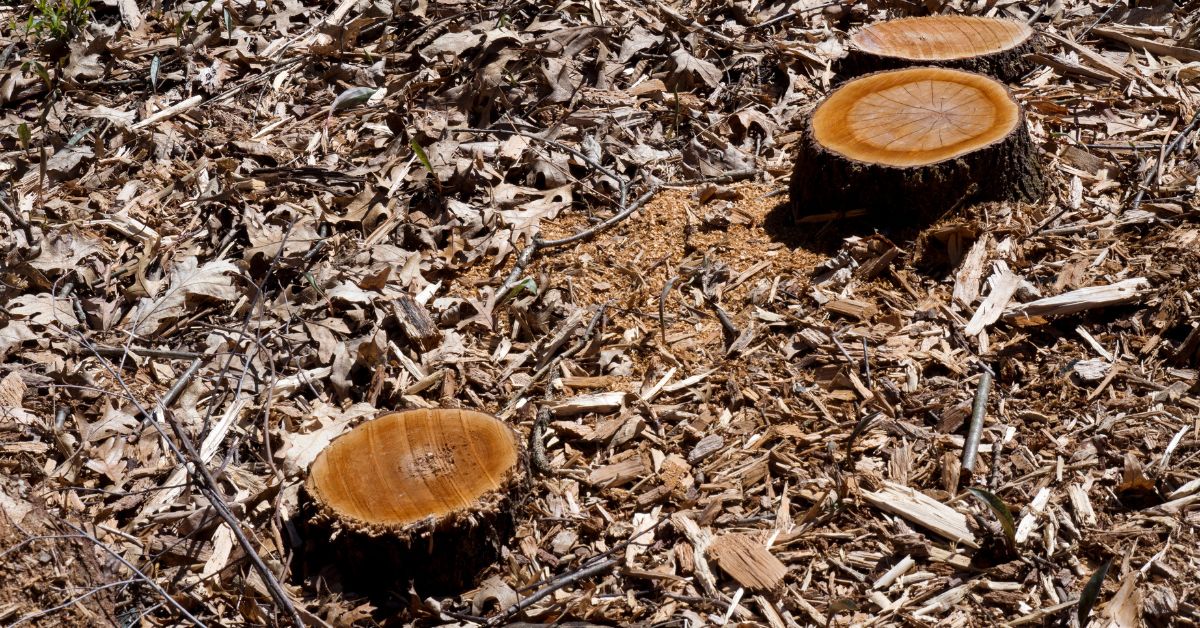stump grinding mulch

What Happens to the Mulch? Clean-up and Site Restoration
Book a stump grind and you’ll see a neat pile of shredded wood chips left behind. This is stump grinding mulch—a by-product of turning the stump and surface roots into chips. Done right, the clean-up and site restoration are straightforward, and that mulch can be put to work in your garden. Here’s what to expect, plus smart stump grinding mulch uses that save time and money.
Mulch reuse
Stump grindings are essentially fresh, coarse wood chips mixed with a little soil. They’re great for paths, suppressing weeds in garden beds, and protecting bare soil while new plants establish. If you’re keeping the mulch on site, spread it in a loose layer 50–75 mm deep around trees and ornamentals, keeping it a small hand’s width away from trunks and stems to avoid moisture build-up against bark.
Fresh chips are “carbon-rich,” which means they break down slowly on the surface—ideal for mulching beds and informal pathways. If you plan to dig them into the soil, do so only in out-of-the-way areas and balance with compost, as the decomposition process can temporarily tie up nitrogen. For most gardens, surface application is the better choice.
If you don’t want the chips, let us know before the job. We can remove excess material or stockpile it neatly for later use.
Backfilling
After grinding, there’s a void where the stump used to be. Our team rakes the stump grinding mulch back into that cavity to create a gentle mound slightly above surrounding ground level. This is intentional. As the mulch settles over a few weeks, it drops back close to grade rather than leaving a hollow.
Where surface roots have been chased out, we tidy those channels too. If your site is on a slope or prone to washouts, we’ll compact lightly and shape the area to shed water evenly. Clear access and a tidy edge line around the work zone make the rest of your garden usable straight away.
Lawn/planting prep
What you do next depends on your plan for the area:
- Re-turfing a lawn: Scrape back the top 50–75 mm of grindings from the surface and set them aside for use elsewhere. Fill the top of the cavity with a quality turf underlay or sandy loam, level to surrounding turf, and lightly compact. Lay new turf as usual and keep it well watered for establishment. A thin layer of grindings can be used around trees, but avoid mixing large amounts through your turf base.
- New garden bed: Leave a portion of the stump grinding mulch in place to act as a base layer. Add 50–100 mm of compost or soil conditioner on top, then plant into that improved layer. Finish with a clean mulch cap (you can use some grindings blended with compost, or your preferred mulch) to present a consistent look.
- Pathway or utility zone: Spread grindings to create a soft, permeable path. For a firmer finish, lay geofabric first and top with decorative chip or gravel. The stump mulch becomes a stabilising sub-layer that reduces mud and dust.
Whichever path you choose, keep irrigation and drainage in mind. Good water flow reduces future root seeking, protects foundations, and keeps your landscaping healthier.
Optional topsoil
There are times when bringing in topsoil is the best move:
- You want instant lawn level: Import a screened turf underlay for the top 75–100 mm. This gives the roots a clean, nutrient-available zone and speeds establishment.
- You’re planting straight away: A blend of topsoil and compost above the cavity creates a fertile layer for seedlings and shrubs.
- You prefer a uniform finish: If the look matters (front yard, rental handover, property sale), a new topsoil layer topped with a consistent mulch gives a polished result.
If you’re unsure, we’ll talk it through on site. The decision often comes down to timing, budget and the final surface you’re aiming for.
Pro advice
Affordable Tree Service is about more than removing a tree—we focus on a smooth, ethical process and a tidy finish. With decades of experience, we’ll help you decide whether to keep or remove stump grinding mulch, how to backfill properly, and the best way to prep for turf or planting.
A quick tip on expectations: fresh grindings settle. That’s normal. Lightly top up low spots after a few weeks, and avoid driving heavy vehicles over the area until the fill has compacted naturally or been reinforced with topsoil.
Planning a stump removal and want the site looking spot-on afterwards? Talk to Affordable Tree Service. We’ll manage the grind, advise on stump grinding mulch uses, handle backfilling, and, if you like, supply optional topsoil and a clean mulch finish.
Affordable means peace of mind—a hassle-free process, environmental care and a tidy result you’ll be happy to live with. Get in touch and let’s restore your garden the right way.
Call Us Today
(07) 3353 4433 or 0411 599 995.
Or email trees@affordabletreeservice.com.au
